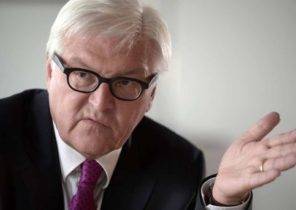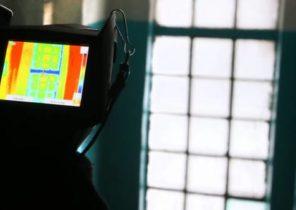Quantum tunneling will not help you to slip through a brick wall to platform 9¾ to catch the Express to Hogwarts. But this effect, in which quantum particles can pass through insurmountable, it would seem, barriers, remains paradoxical and disproving our internal intuition of phenomenon. Experimental physics from Toronto used rubidium atoms to explore this effect, and for the first time measured the amount of time the atoms pass through an obstacle. Their findings they published in the journal “nature” (Nature) on July 22.
Scientists have shown that quantum tunneling is not instantaneous, at least in one of the views about this phenomenon, although recent data suggest otherwise. “This is a great experiment, — says Igor litvinyuk, working in Australia at the Griffith University and specializing in the problem of quantum tunneling. — To spend it, it took a heroic effort”.
In order to evaluate all the strangeness of quantum tunneling, get the ball rolling on a flat surface and suddenly encounters a small rounded mound. What happens next depends on the speed of the ball. He either has come to the top and then slide down the opposite slope, or a little climb up, and then slip back, because he will not have enough energy to take the height.
But these rules do not apply to particles in the quantum world. Even when the particle has insufficient energy to roll over the top of the hill, it sometimes gets to the opposite edge. “As if a particle breaks through the tunnel under the hill and appears on the other side,” says study co-author Ephraim Steinberg (Aephraim Steinberg) from the University of Toronto.
Such foibles easier to understand if you think about the wave function of a particle, which is a mathematical expression of the quantum state. The wave function is developed and distributed. Its amplitude in time and space at one point or another allows us to calculate the probability of finding the particle exactly there and then — if we make the measurement. By definition, this probability can be different from zero in many places at the same time.
If the particle encounters an energy barrier, such a collision changes the distribution of the wave function, which starts to die away exponentially inside the barrier. However, some of it still leaks out, and on the opposite side, its amplitude is not reduced to zero. Thus, it remains insignificant but finite probability of finding the particle outside the barrier.
Physicists know about quantum tunneling since the late 1920-ies. Today this phenomenon is the basis of devices such as tunnel diodes and scanning tunneling microscopes and superconducting qubits for quantum computing.
Since quantum tunneling, the researchers are trying to better understand what exactly occurs during tunneling. So, in 1993 Steinberg, Paul Kwiat (Paul Kwiat) and Raymond Chow (Raymond Chiao), who worked at that time at the University of California, Berkeley, discovered the photons passing through the optical barrier (a special piece of glass that reflects 99% of incident photons and transmits one percent). Tunnelling photons on the average appear before those that held the same distance but without barriers. It seemed that tunneling photons travel faster than speed of light.
Careful analysis has shown that, mathematically speaking, is the peak of the wave function tunneling of photons (the most likely place for finding the particles), which move with superluminal speed. But front-edge wave functions of freely moving photons and tunneling photon reaches its detection devices at the same time, that is, there is no violation of Einstein’s relativity theory. “The peak of the wave function can be faster than light-light movement of information or energy,” says Steinberg.
Last year litvinyuk with his colleagues published the results of the study showed that when electrons in hydrogen atoms are constrained by external electric field that acts as a barrier, they from time to time are tunneling through it. Since the intensity of the external field fluctuates, so does the number of tunneling electrons, as predicted by the theory. This team found that the time lag between the moment when the barrier reaches its minimum, and when the maximum number of electrons tunnels through it is a maximum of 1.8 attosecond (one billionth part of a billionth of a second). Even the light having a velocity of 300 000 kilometers per second, one attosecond is only three ten-billionth of one meter, that is, the distance of the size of the atom. “The time delay may be zero or to be a few zeptosecond (one thousandth of attosecond),” said litvinyuk.
Some media made a very controversial statement that an experiment conducted at the University of Griffith, proved by the instantaneous tunneling. Such confusion is largely due to the theoretical definitions of tunneling time. The time lag, which was measured by scientists, definitely was close to zero, but it is not possible to say that the electron actually does not hold the barrier any time. Litvinyuk colleagues did not investigate this aspect of quantum tunneling.
Steinberg, as a result of the new experiment says exactly that. His team measured how much time on average rubidium atoms spend inside the barrier before breaking through it. This time is on the order of milliseconds. So the call tunneling is instantaneous does not.
For a start, Steinberg and his colleagues cooled rubidium atoms to about one nanokelvin, and then sent them using lasers in one direction at low speed. The researchers then blocked them off another laser, creating optical barrier thickness of about 1.3 microns. The task was to measure the time spent by a particle inside the barrier in the tunneling process.
For these purposes, scientists have designed a kind Ermolovich hours, using a complex system of lasers and magnetic fields to manipulate the atomic state transitions. In principle, the following occurs. Imagine a particle that rotates in a direction as arrow hours. The particle strikes the barrier, and inside it is a magnetic field that causes the arrow to rotate. The longer the particle will remain inside the barrier, the more it will interact with the magnetic field, and the more will spin the arrow. The amount of rotation corresponds to the time spent by the particle inside the barrier.
Unfortunately, if the particle interacts with a magnetic field powerful enough to correctly encode past tense, it will come out of the quantum state. The tunneling process is violated.
For this reason, Steinberg colleagues have used the method of weak measurements. The group is equally prepared rubidium atoms approaches the barrier. Inside the barrier the atoms fall in a weak magnetic field, which almost do not interact. This weak interaction does not interfere with the tunneling. But it makes the clock of each atom to undergo an unpredictable distance that can be measured at the exit of the atom from the barrier. Take the average position of the hands of a group of atoms and obtain the number that can be represented as the correct value for a single atom, even though such individual measurements are impossible. After such a weak measurement, the researchers came to the conclusion that the atoms in their experiment is performed inside the barrier about of 0.61 milliseconds.
They also checked another strange quantum mechanics thesis: the less power or slower than the motion of the tunneling particle, the less time she spends inside the barrier. It is an illogical result, because according to our beliefs about the world, the slower the particle needs to be longer inside the barrier.
Measuring the rotation of the clock hands made a big impression on Litvinyuk. “I don’t see any flaws,” he says. However, the scientist do not jump to conclusions. “You can interpret how it relates to the tunneling time”, says the physicist.
Quantum physicist Irfan Siddiqi (Irfan Siddiqi) at the University of California at Berkeley is impressed with the technical complexity of the experiment. “What we saw was just amazing, as we now have the tools to check all of these philosophical reflections of the last century,” he says.
Sathya Sainath of Endurci (Satya Sainadh Undurti), who worked in the team’s Litvinyuk, and now teaches at the Israeli Institute of technology in Haifa, I agree with him. “Ermolovy watch is definitely the right way to search for answers to questions about the time of the tunneling, he says. — Set out in the scheme of the experiment is a clever and clean way to implement it”.
Steinberg acknowledges that some quantum physicists to doubt the findings and explanations of his team, especially those who are weak measurements seem questionable. However, he believes that the experiment points to something undeniable in terms of time of tunneling. “If we use the correct definitions, tunneling is not instantaneous. It just flows amazingly quickly, the scientist said. And I think that this is still a very big difference.”







